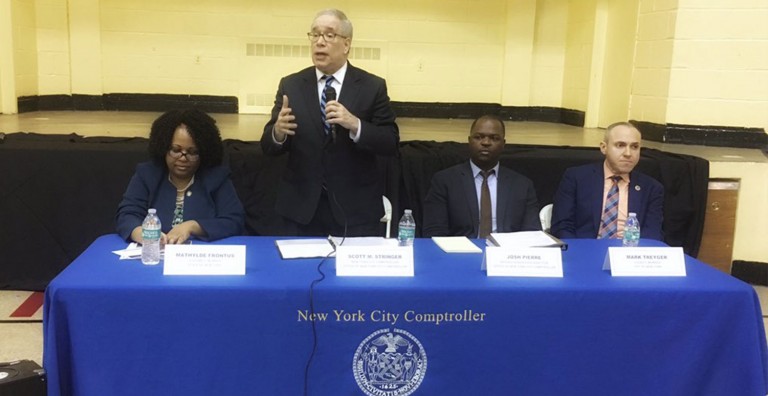Photo Courtesy of Comptroller Stringer’s Office
“While the new leadership deserves credit for trying to clean things up, the MTA still has a long way to go to ensure accuracy and reliability and to regain the public’s trust,” Comptroller Stringer said.
By Forum Staff
The Metropolitan Transportation Authority has misrepresented its performance and delay data for years and shifted the focus from the subways’ real operational problems, according to an investigation released on Friday by City Comptroller Scott Stringer.
Relying on internal documents primarily prepared by the MTA’s Performance Analysis Unit, as well as interviews with key agency officials, Stringer’s staff found that the MTA failed to provide clear guidance on how to identify the causes of millions of delays, relied on distorted metrics to report system progress, and hid delay data where causes were unknown.
“It is an insult to anyone who has ever been late to work or stranded at the station that MTA leadership passed along bogus delay data just to make the agency look good, even as its own staff were raising red flags,” the comptroller said. “While the new leadership deserves credit for trying to clean things up, the MTA still has a long way to go to ensure accuracy and reliability and to regain the public’s trust. For too long the MTA has failed to transparently report what is actually going on underground, a problem which can only mean more delays and more frustration for the working New Yorkers who rely on the subway every day.”
Stringer indicated that he’s calling on the beleaguered MTA to:
• Structure public reporting of delay data to maximize transparency, reliability and accountability.
• Publicly define all delay categories, specifically indicating what each one includes and, as necessary, omits.
• Ensure that all protocols relevant to performance reporting are formally codified in official policies and procedures, including establishing written definitions and instructions for all key terms, data categories, and work protocols.
• Adequately train all relevant personnel on protocols relevant to performance reporting.
• In the context of public reports of “Major Incidents,” provide the public with information about all categories of service disruptions tracked as incidents within its Subway Incident Reporting System that cause 50 or more delays, including specifically “Planned Work.”
• Transparently disclose in each Monthly Operations Report and on the MTA’s subway performance dashboard, the methodologies used to calculate performance metrics, including all exceptions and revisions to those methodologies, and including methodological weaknesses.
• Make available on the MTA’s website or through an Open Data portal each month all data in the SIRS database and any other databases relied on for public reporting.
Stringer noted that at the December 2018 Transit Committee meeting, MTA New York City Transit President Andy Byford conceded that the MTA’s recent success reducing delays was the result of “things that could and should have probably been done a long time ago. No brainers. Things that actually don’t necessarily cost very much but just I hope demonstrate greater attention to detail.” As the MTA has attributed approximately 30 percent of all delays in December 2018 to “Operating Environment,” work to address these delays must continue, Stringer said.
The comptroller also pointed out that under Byford, the MTA has acknowledged some of these issues, introduced reforms, and begun to reduce delays.

